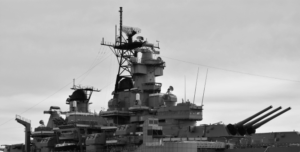Asbestos was used on U.S. Navy battleships in many different ways. Battleships often used asbestos insulation. Pipes, boilers, and other heavy equipment were also blanketed with it. You can get benefits from the U.S. Department of Veterans Affairs (VA), as well as medical care and financial aid, if you got sick from asbestos on battleships.
Asbestos on Battleships Explained
Battleships were once an important part of the U.S. Navy's fleet. They are large, heavily armored warships containing many heavy guns for use during battles at sea.
Battleships were especially prevalent in the 1800s and early 1900s. However, after World War II, most battleships were decommissioned, and aircraft carriers took their place. Only a handful of those ships remained active through the 1990s.
That said, many Navy personnel served aboard battleships in the mid-20th century — and much of these ships were built with asbestos. Asbestos was a highly durable material, but it's known as a cancer-causing substance today.
Those who served aboard U.S. battleships that used asbestos could develop:
- Mesothelioma
- Asbestosis
- Lung cancer
- Other asbestos-related diseases
Fortunately, veterans who developed mesothelioma can pursue benefits from the VA and compensation from makers of asbestos-based products. Get a Free Veterans Packet to see if you qualify.
List of Battleships With Asbestos
At least 36 U.S. battleships and hundreds of other Navy ships are known to have used asbestos.
Battleships built with asbestos included:
- USS Alabama (BB-60)
- USS Arizona (BB-39)
- USS Arkansas (BB-33)
- USS California (BB-44)
- USS Colorado (BB-45)
- USS Indiana (BB-58)
- USS Iowa (BB-61)
- USS Maryland (BB-46)
- USS Massachusetts (BB-59)
- USS Missouri (BB-63)
- USS Nevada (BB-36)
- USS New Hampshire (BB-70)
- USS New Jersey (BB-62)
- USS North Carolina (BB-55)
- USS Pennsylvania (BB-38)
- USS South Dakota (BB-57)
- USS Washington (BB-56)
- USS Wisconsin (BB-64)
According to reports by the U.S. Navy, the four Iowa-class ships — the USS Iowa, New Jersey, Missouri, and Wisconsin — had nearly 500 tons of heat insulation per ship, which likely contained asbestos.
Asbestos Exposure Risks on Battleships
Anyone who lived, worked, or served on battleships was in danger of asbestos exposure. Due to government mandates, nearly every U.S. Navy vessel relied on asbestos for decades, including battleships.
Areas of the ship that commonly used asbestos included the boiler rooms and engine rooms. Asbestos covered the boilers and the equipment used in the engine rooms.
Any time these parts were overhauled or built, asbestos was released and became airborne, where it could have been inhaled or ingested.
Asbestos-Containing Products on Battleships


However, the insulation could break down in damp conditions, sending fibers into the air.
Machinery and pipe insulation aboard the battleships also used asbestos, meaning as these parts were handled, installed, or replaced, fibers could be released. Since the ventilation on these ships was so poor, the air was often rife with asbestos fibers.
Other asbestos products on battleships included:
- Adhesives
- Boilers
- Gaskets
- Valves
The asbestos fibers released from these products can get stuck in the lining of the lungs, abdomen, heart, or testicles. Once inside the body, the fibers can never be removed and will irritate healthy cells and tissues. After 10-50 years, Navy veterans exposed to asbestos on battleships could develop asbestosis, lung cancer, or mesothelioma.
Did you or a loved one get sick after using asbestos-based products on a ship? Get a Free Veterans Packet to see if you qualify for VA benefits.
Shipyards & Asbestos Exposure
It was not only the sailors themselves who were exposed to asbestos — people who worked on battleships and other vessels in Naval shipyards were also exposed to asbestos when replacing damaged areas of insulation or putting in new insulation.
It's believed that 4.5 million people were exposed to asbestos in shipyards during World War II — a time period when battleships were widely used by the U.S. Navy. The New York Times noted that many who served in these shipyards worked in thick clouds of asbestos dust.
While there are no longer battleships in today’s Navy, thousands of shipyard workers and sailors were already exposed. Today, one-third of all mesothelioma cases are linked back to service in the U.S. Navy or a shipyard.
Get a Free Veterans Packet now if you have mesothelioma or another asbestos-related disease after serving on a U.S. Navy battleship or working in a shipyard. You may qualify for military benefits, help finding treatments, and compensation.
History of Asbestos on Battleships
Battleships were built to last. Because they were made from steel armor plating and used asbestos for insulation and fireproofing, they could withstand enemy attacks.
However, Navy personnel aboard battleships had no idea that asbestos products were dangerous. Manufacturers of these products hid the risks for decades from service members and the general public — making billions of dollars in the process.
The U.S. Navy actually mandated the use of asbestos on battleships and other Navy vessels due to the perceived benefits — and because the risks weren't fully understood by anyone except greedy companies.
Battleships relied on asbestos-containing products through World War II and beyond. It wasn't until the early 1980s that major renovation efforts began to remove asbestos from battleships and other Navy vessels.
By that time, far too many Navy service members had already been exposed to asbestos, putting them at risk of developing mesothelioma 10-50 years later.
Compensation & Resources for Veterans Harmed by Asbestos on Battleships
There are many resources for veterans who developed mesothelioma from being exposed to asbestos on battleships. Learn about top mesothelioma compensation options and other helpful resources below.
Mesothelioma VA Benefits
Veterans with mesothelioma can pursue a wide range of VA benefits following a diagnosis.
Top mesothelioma VA benefits include:
- Disability compensation worth $3,946.25 a month
- Free or low-cost medical care from top cancer doctors
- Survivor benefits for loved ones
The VA typically provides the highest monthly payouts and lowest health care premiums to mesothelioma veterans since this cancer is considered a total disability.
Get help filing for or increasing your VA benefits to 100% by working with our team.
Mesothelioma Lawsuits
Veterans with mesothelioma can file asbestos lawsuits to pursue compensation from private manufacturers with no action taken against the military or government.
The average mesothelioma lawsuit awards $1 million, with payouts varying by case.
The Mesothelioma Veterans Center’s legal partners have secured millions of dollars for U.S. Navy veterans who served on battleships and later developed mesothelioma.
Recent asbestos battleship settlements we’ve secured include:
- $1.59 million to an Iowa veteran who was a gunner’s mate on the USS Alabama
- $1.57 million to a Florida veteran who was a naval operator on the USS Wyoming
- $1.55 million to an Illinois veteran who served as a quartermaster on the USS Mt. Olympus and USS Wyoming
- $1.23 million for a Wisconsin Navy veteran who worked on the USS New Jersey and other vessels in shipyards
- $1.1 million to an Ohio machinist mate who worked on the USS Wisconsin
Call (877) 450-8973 to learn if you may qualify to file an asbestos lawsuit and secure compensation.
Asbestos Trust Funds
It might be possible to get compensation by filing claims with asbestos trust funds. These trusts were set up by manufacturers of asbestos-containing products that filed for bankruptcy protection to avoid lawsuits.
There are dozens of asbestos trust funds active today with over $30 billion available in total.
You or a U.S. veteran with mesothelioma who you love may qualify to file claims with several trusts, depending on which products you were exposed to.
Help for Veterans With Mesothelioma After Serving on Battleships
Anyone who served on U.S. battleships or other Navy vessels could have been exposed to asbestos fibers, even those who did not directly handle the products.
As a result of this exposure, roughly 1,000 veterans develop mesothelioma each year, with many more suffering from other asbestos-related illnesses.
The Mesothelioma Veterans Center stands ready to help eligible veterans and loved ones receive the benefits, treatments, and compensation they deserve after a diagnosis. Our team of U.S. veterans, patient advocates, nursing support personnel, and VA-accredited lawyers is standing by to help you right now.
If you developed mesothelioma after serving on a battleship, get a Free Veterans Packet today.
Asbestos on Battleships FAQs
Which U.S. Navy ships had asbestos?
Almost every U.S. Navy ship in service between the 1930s and early 1980s, including 36 battleships, had asbestos aboard.
Notable battleships that used asbestos included the USS Iowa, USS Maryland, USS Pennsylvania, and USS Massachusetts.
Anyone exposed to asbestos on battleships could develop mesothelioma or other dangerous diseases 10-50 years later.
How did the U.S. Navy use asbestos on battleships?
Asbestos was used in almost every U.S. battleship due to government mandates to keep them well-insulated.
Asbestos-containing insulation, piping, gaskets, and valves were found throughout battleships. Common places where asbestos was used aboard these vessels included engines and boilers.
Call (877) 450-8973 if you believe you developed mesothelioma after serving on a battleship. We can help you access mesothelioma VA benefits and other top resources if you qualify.
Why did the U.S. Navy use asbestos on battleships if it was dangerous?
The risks of asbestos exposure weren't known by most people who served in the U.S. Navy until millions had already been exposed.
The manufacturers of asbestos-containing products concealed the dangers from service members and the general public. These manufacturers knew asbestos was harmful but never said a word.
Instead, they focused on the benefits of asbestos, allowing millions of Navy personnel and shipyard workers to be put in danger.
Does the military still use asbestos?
The military no longer uses asbetsos-containing products to make new ships.
Significant renovation efforts were also undertaken to remove asbestos from battleships and other vessels in the 1980s when the risks were fully understood.
Only a handful of U.S. battleships were still in service by the time these renovations began.
Still, millions of Navy personnel had already been exposed to asbestos on battleships and other Navy vessels by this point.
The Mesothelioma Veterans Center stands ready to help veterans who developed mesothelioma after serving on battleships. Get a Free Veterans Packet to learn about medical, financial, and military benefits available to you.
Why did the U.S. Navy stop using battleships?
The U.S. Navy largely stopped using battleships after World War II because they weren't cost-effective, according to the National Interest. Aircraft carriers were much more favored over battleships.
Instead of directly fighting from ship to ship, aircraft carriers held airplanes that took off to fight battles in the air and on land. These ships had more attack power when compared to battleships.
Unfortunately, both battleships and aircraft carriers often contained asbestos, meaning anyone aboard these vessels could be in danger of mesothelioma today.


